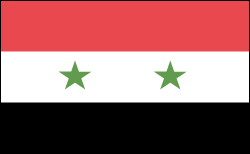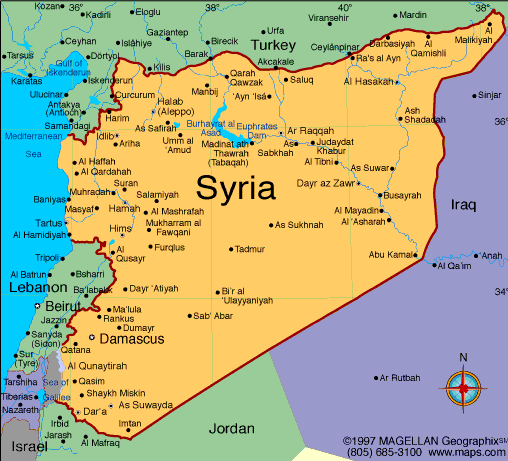SYRIA

Geography: Slightly larger than North Dakota, Syria lies at the eastern end of the Mediterranean Sea. It is bordered by Lebanon and Israel on the west, Turkey on the north, Iraq on the east, and Jordan on the south. Coastal Syria is a narrow plain, in back of which is a range of coastal mountains, and still farther inland a steppe area. In the east is the Syrian Desert and in the south is the Jebel Druze Range. The highest point in Syria is Mount Hermon (9,232 ft; 2,814 m) on the Lebanese border.
Government: Republic under a military regime since March 1963.
History: Ancient Syria was conquered by Egypt about 1500 B.C. , and after that by Hebrews, Assyrians, Chaldeans, Persians, and Alexander the Great of Macedonia. From 64 B.C. until the Arab conquest in A.D. 636, it was part of the Roman Empire except during brief periods. The Arabs made it a trade center for their extensive empire, but it suffered severely from the Mongol invasion in 1260 and fell to the Ottoman Turks in 1516. Syria remained a Turkish province until World War I.
A secret Anglo-French pact of 1916 put Syria in the French zone of influence. The League of Nations gave France a mandate over Syria after World War I, but the French were forced to put down several nationalist uprisings. In 1930, France recognized Syria as an independent republic but still subject to the mandate. After nationalist demonstrations in 1939, the French high commissioner suspended the Syrian constitution. In 1941, British and Free French forces invaded Syria to eliminate Vichy control. During the rest of World War II, Syria was an Allied base. Again in 1945, nationalist demonstrations broke into actual fighting, and British troops had to restore order. Syrian forces met a series of reverses while participating in the Arab invasion of Palestine in 1948. In 1958, Egypt and Syria formed the United Arab Republic, with Gamal Abdel Nasser of Egypt as president. However, Syria became independent again on Sept. 29, 1961, following a revolution.
In the Arab-Israeli War of 1967, Israel quickly vanquished the Syrian army. Before acceding to the UN cease-fire, the Israeli forces took control of the fortified Golan Heights. Syria joined Egypt in attacking Israel in Oct. 1973 in the fourth Arab-Israeli War, but was pushed back from initial successes on the Golan Heights and ended up losing more land. However, in the settlement worked out by U.S. secretary of state Henry A. Kissinger in 1974, the Syrians recovered all the territory lost in 1973.
In the mid-1970s Syria sent some 20,000 troops to support Muslim Lebanese in their armed conflict with Christian militants supported by Israel during the civil war in Lebanon. Syrian troops frequently clashed with Israeli troops during Israel's 1982 invasion of Lebanon and remained thereafter as occupiers of large portions of Lebanon.
Government: Republic under a military regime since March 1963.
History: Ancient Syria was conquered by Egypt about 1500 B.C. , and after that by Hebrews, Assyrians, Chaldeans, Persians, and Alexander the Great of Macedonia. From 64 B.C. until the Arab conquest in A.D. 636, it was part of the Roman Empire except during brief periods. The Arabs made it a trade center for their extensive empire, but it suffered severely from the Mongol invasion in 1260 and fell to the Ottoman Turks in 1516. Syria remained a Turkish province until World War I.
A secret Anglo-French pact of 1916 put Syria in the French zone of influence. The League of Nations gave France a mandate over Syria after World War I, but the French were forced to put down several nationalist uprisings. In 1930, France recognized Syria as an independent republic but still subject to the mandate. After nationalist demonstrations in 1939, the French high commissioner suspended the Syrian constitution. In 1941, British and Free French forces invaded Syria to eliminate Vichy control. During the rest of World War II, Syria was an Allied base. Again in 1945, nationalist demonstrations broke into actual fighting, and British troops had to restore order. Syrian forces met a series of reverses while participating in the Arab invasion of Palestine in 1948. In 1958, Egypt and Syria formed the United Arab Republic, with Gamal Abdel Nasser of Egypt as president. However, Syria became independent again on Sept. 29, 1961, following a revolution.
In the Arab-Israeli War of 1967, Israel quickly vanquished the Syrian army. Before acceding to the UN cease-fire, the Israeli forces took control of the fortified Golan Heights. Syria joined Egypt in attacking Israel in Oct. 1973 in the fourth Arab-Israeli War, but was pushed back from initial successes on the Golan Heights and ended up losing more land. However, in the settlement worked out by U.S. secretary of state Henry A. Kissinger in 1974, the Syrians recovered all the territory lost in 1973.
In the mid-1970s Syria sent some 20,000 troops to support Muslim Lebanese in their armed conflict with Christian militants supported by Israel during the civil war in Lebanon. Syrian troops frequently clashed with Israeli troops during Israel's 1982 invasion of Lebanon and remained thereafter as occupiers of large portions of Lebanon.

Map of Syria
President: Bashar al-Assad (2000)
Prime Minister: Riyad Farid Hijab
(2012)
Land area: 71,062 sq mi (184,051 sq
km); total area: 71,498 sq mi (185,180 sq km)
Population (2014 est.): 17,951,639
(growth rate: -9.73%); birth rate: 22.76/1000; infant mortality rate:
15.79/1000; life expectancy: 68.41; density per sq mi: 306.5
Capital (2011 est.):
Damascus, 2.65 million
Other large cities: Aleppo,
3.164 million; Hims, 1.369 million;
Hamah, 933,000
Monetary unit: Syrian pound
National
name: Al-Jumhuriyah al-'Arabiyah as-Suriyah
Languages:
Arabic (official); Kurdish, Armenian, Aramaic,
Circassian widely understood; French, English somewhat
understood
Ethnicity/race:
Arab 90.3%, Kurds, Armenians, and other
9.7%
Religions:
Muslim 87% (official; includes Sunni 74% and Alawi,
Ismaili, and Shia 13%), Christian (includes Orthodox, Uniate, and
Nestorian) 10% (includes Orthodox, Uniate, and Nestorian), Druze 3%,
Jewish (few remaining in Damascus and Aleppo)
Literacy rate: 84.1% (2011 est.)
Economic summary: GDP/PPP (2011 est.):
$107.6 billion; per capita $5,100. Real growth rate: -2.3%.
Inflation: 59.1% (2013 est.). Unemployment: 17.8% (2013 est.). Arable land:
24.9%. Agriculture: wheat, barley, cotton, lentils,
chickpeas, olives, sugar beets; beef, mutton, eggs, poultry, milk.
Labor force: 5.014 million (2013 est.); agriculture 17%,
industry 16%, services 67% (2008 est.). Industries:
petroleum, textiles, food processing, beverages, tobacco, phosphate
rock mining, cement, oil seeds crushing, automobile assembly. Natural resources: petroleum, phosphates, chrome
and manganese ores, asphalt, iron ore, rock salt, marble, gypsum,
hydropower. Exports: $2.675 billion (2013
est.): crude
oil, minerals, petroleum products, fruits and vegetables, cotton
fiber, textiles, clothing, meat and live animals, wheat. Imports: $8.917 billion
(2013 est.): machinery and transport equipment, electric power
machinery, food and livestock, metal and metal products, chemicals and
chemical products, plastics, yarn, paper. Major trading partners:
Iraq, Saudi Arabia, China, Kuwait, Iran, UAE, Libya (2012).
Communications:
Telephones: main lines in use: 4.425 million (2012); mobile
cellular: 12.928 million (2012) Radio broadcast stations: AM 14, FM 2, shortwave
1 (2007). Radios: 4.15 million (1997). Television broadcast
stations: 44 (plus 17 repeaters) (1995). Televisions: 1.05
million (1997). Internet Service Providers (ISPs): 416 (2012).
Internet users: 4.469 million (2009).
Transportation: Railways: total: 2,052 km
(2008). Highways: total: 69,873 km; paved: 63,060 km (including
1,103 km of expressways); unpaved: 6,813 km (2010). Waterways:
900 km; minimal economic importance. Ports and harbors:
Baniyas, Latakia, Tartus. Airports: 90
(2013).
International disputes: Golan
Heights is Israeli-occupied with the almost 1,000-strong UN
Disengagement Observer Force patrolling a buffer zone since 1964;
lacking a treaty or other documentation describing the boundary,
portions of the Lebanon-Syria boundary are unclear with several sections
in dispute; since 2000, Lebanon has claimed Shab'a Farms in the Golan
Heights; 2004 Agreement and pending demarcation settles border dispute
with Jordan.
-------------------- o --------------------
No comments:
Post a Comment